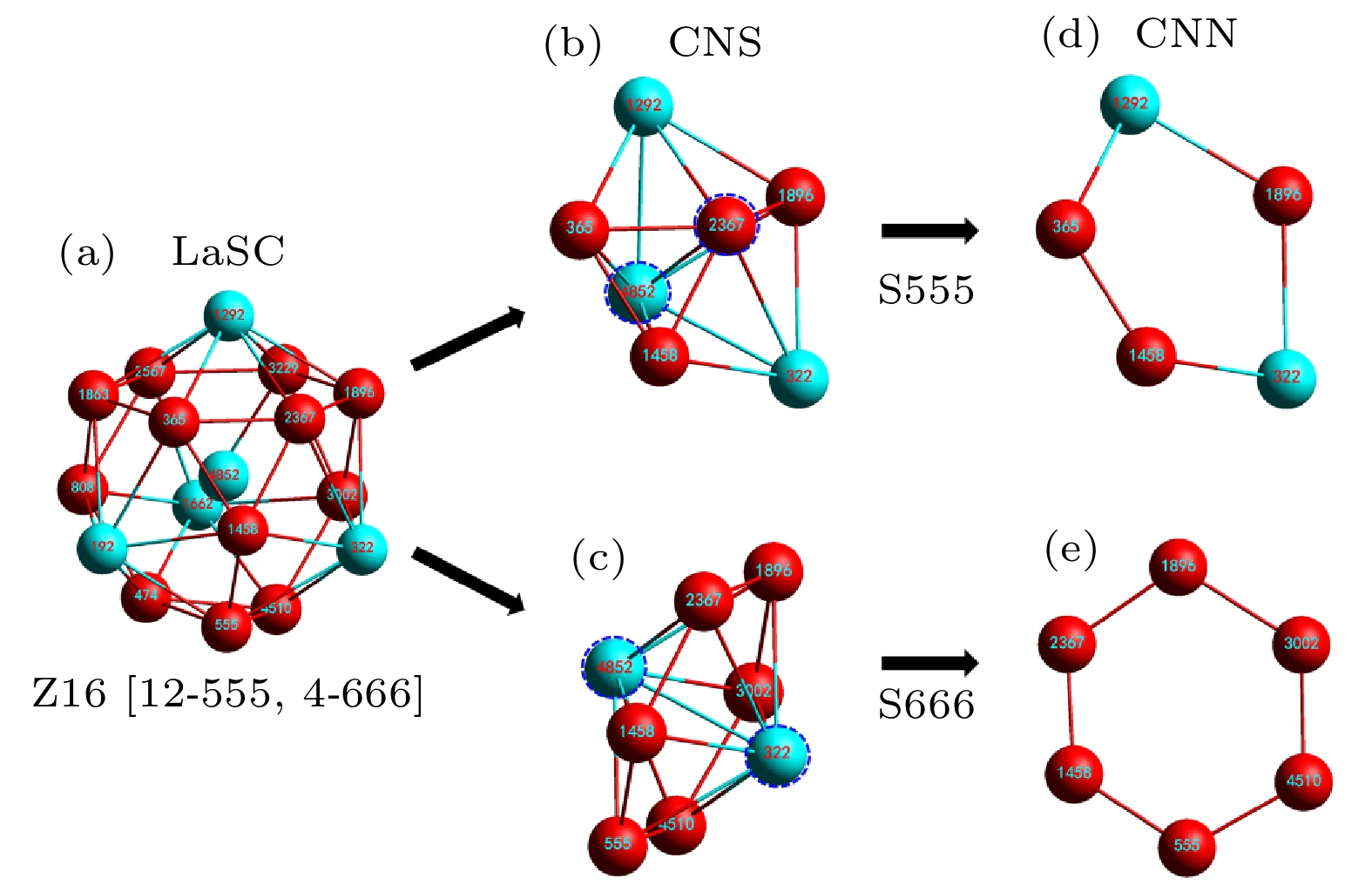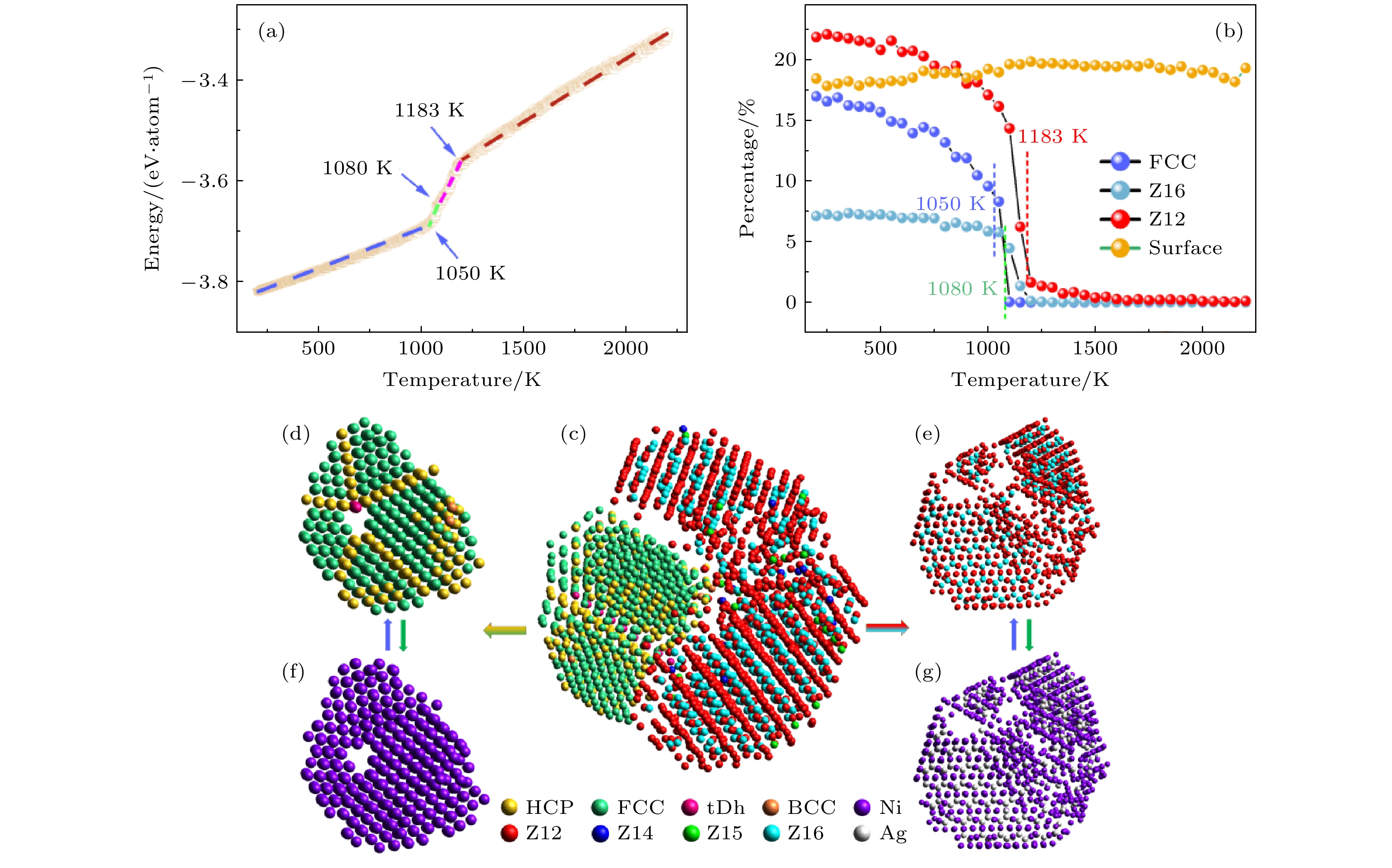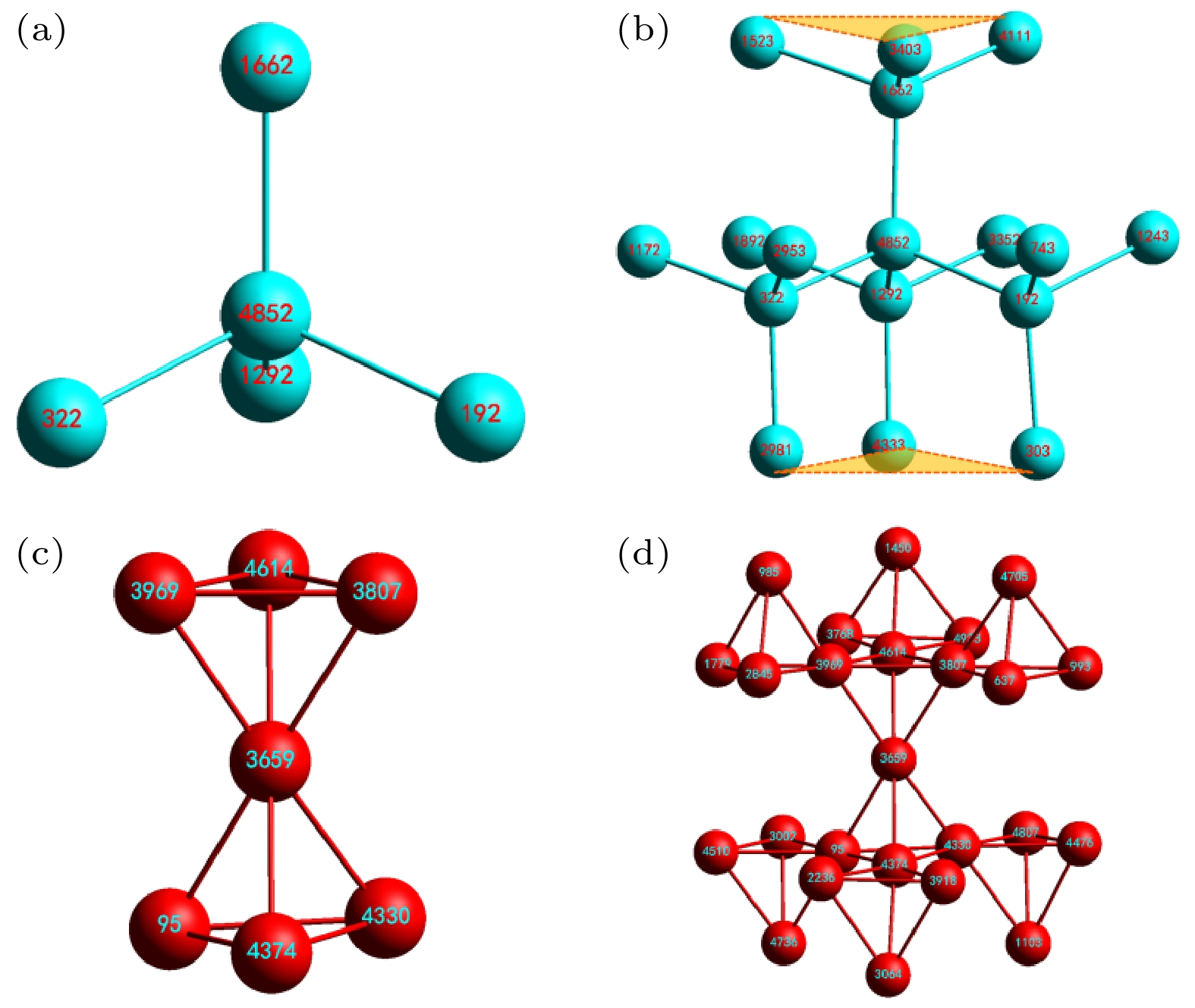-
模拟计算已经成为材料科学的重要手段, 从模拟计算输出的原子坐标得到体系的结构特征是研究材料结构与性能相关性的前提. 对于晶胞只含2—6个原子的简单(BCC, HCP和FCC)晶体, 数值分析方法只需要确定每个原子的局域特征, 拓扑结构相同的原子相互连接即构成晶体区域. 但要确定含有几十上百个原子的晶胞, 数值方法的计算量极大. 数值分析与可视化相结合是解决此类问题的方法之一. 本文采用分子动力学方法快凝得到Ni70Ag30纳米颗粒, 发现纳米颗粒含有FCC晶体和大量结构复杂的拓扑密堆(TCP)结构. 利用基于最大标准团簇的分析软件提供的多种可视分析功能, 结合晶体学相关知识, 采用拓扑构型分析思路, 确定了纳米颗粒中的TCP原子构成C15相. 本文使用的分析思路为将来开发复杂晶体结构数值识别软件提供了算法逻辑.Simulation has become an important tool in materials science, it is a prerequisite to study the correlation between the structure and properties of materials, in that the structural characteristics of the system from the atomic coordinates output can be obtained by simulations. For simple (FCC, HCP, and BCC) crystals containing only 2-6 atoms, in the numerical analysis method, what needs to be determined is only the local characteristics of each atom. However, it is extremely computationally intensive to determine the cells containing tens or hundreds of atoms. The combination of numerical analysis and visualization is one of the methods to solve this kind of problem. In this work, Ni70Ag30 nanoparticles are simulated by molecular dynamics. It is found that the nanoparticles contain FCC crystals and a large number of complex topologically close-packed (TCP) structures. Using the analysis software based on the largest standard cluster analysis (LaSCA), the C15 phase of TCP atoms in nanoparticles is determined by topology configuration analysis and crystallography knowledge. The analytical ideas provide the algorithm logic fordeveloping the numerical recognition software for complex crystal structures in the future.
-
Keywords:
- Laves phase /
- LaSC /
- molecular dynamics simulation /
- rapid cooling
[1] Greer A L 1993 Nature 366 6453
[2] Li C, Li J C, Zhao M, Jiang Q 2009 J. Alloys Compd. 475 752
 Google Scholar
Google Scholar
[3] Turchi P, Treglia G, Ducastelle F 1983 J. Phys. F:Met. Phys. 13 2543
 Google Scholar
Google Scholar
[4] Hartsough L D 1974 J. Phys. Chem. Solids 35 1691
 Google Scholar
Google Scholar
[5] Turchi P E A, Finel A 1992 Phys. Rev. B 46 702
 Google Scholar
Google Scholar
[6] Moriarty J A 1994 Phys. Rev. B 49 12431
 Google Scholar
Google Scholar
[7] Ye H Q, Zhu J 1989 Acta Cryst B 45 1
[8] Li D X, Kuo K H 1985 Philos. Mag. A 51 849
 Google Scholar
Google Scholar
[9] Rehman H UR, Durst K, Neumeier S, Parsa A B, Kostka A, Eggeler G, Göken M 2015 Mater. Sci. Eng. A 634 202
 Google Scholar
Google Scholar
[10] Rae C M F, Reed R C 2001 Acta Mater. 49 4113
 Google Scholar
Google Scholar
[11] Kelchner C L, Plimpton S J, Hamilton J C 1998 Phys. Rev. B 58 11085
 Google Scholar
Google Scholar
[12] Honeycutt J D, Andersen H C 1987 J. Phys. Chem. 91 4950
 Google Scholar
Google Scholar
[13] Faken D, Jónsson H 1994 Comput. Mater. Sci. 2 279
 Google Scholar
Google Scholar
[14] Wang S Y, Tian Z A, Dong K J, Xie Q 2021 J. Alloys Compd. 854 156983
 Google Scholar
Google Scholar
[15] Mauro N A, Wessels V, Bendert J C, Klein S, Gangopadhyay A K, Kramer M J, Hao S G, Rustan G E, Kreyssig A, Goldman A I, Kelton K F 2011 Phys. Rev. B 83 184109
 Google Scholar
Google Scholar
[16] Voronoi G. De Gruyter 1908 Journal für die reine und angewandte Mathematik (Crelles Journal) 134 198
[17] Xie Z C 2021 J. Mater. Res. 36 15
[18] Tian Z A, Liu R S, Dong K J, Yu A B 2011 EPL 96 36001
 Google Scholar
Google Scholar
[19] Tian Z A, Dong K J, Yu A B 2015 Ann. Phys. 354 499
 Google Scholar
Google Scholar
[20] Wu Z Z, Mo Y F, Lang L, Yu A B, Xie Q, Liu R S, Tian Z A 2018 Phys. Chem. Chem. Phys. 20 28088
 Google Scholar
Google Scholar
[21] Lang L, Deng H Q, Tian Z A, Gao F, Hu W Y, Wen D D, Mo Y F 2019 J. Alloys Compd. 775 1184
 Google Scholar
Google Scholar
[22] 栗晶晶, 田泽安 2020 低温 42 81
Li J J, Tian Z A 2020 Low. Temp. Phys. Lett. 42 81
[23] Mo Y F, Tian Z A, Lang L, Liu R S, Zhou L L, Hou Z Y, Peng P, Zhang T Y 2019 J. Non-Cryst. Solids 513 111
 Google Scholar
Google Scholar
[24] Zhou L L, Tian Z A, Liang Y C, Mo Y F, Wang C J, Li F Z 2021 Phys. Chem. Chem. Phys. 23 25933
 Google Scholar
Google Scholar
[25] Plimpton S 1995 J. Comput. Phys. 117 1
 Google Scholar
Google Scholar
[26] Pan Z L, Borovikov V, Mendelev M I 2018 Modell. Simul. Mater. Sci. Eng. 26 075004
 Google Scholar
Google Scholar
[27] Frank F C, Kasper J S 1958 Acta Crystallogr. 11 184
 Google Scholar
Google Scholar
[28] Frank F C, Kasper J S 1959 Acta Crystallogr. 12 483
 Google Scholar
Google Scholar
[29] Ahmed E, Akhter J I, Ahmad M 2004 Comput. Mater. Sci. 31 309
 Google Scholar
Google Scholar
[30] Zheng Q, Xiao T, Tian Z A, Gao T H, Liang Y C, Chen Q, Xie Q 2021 Cryst. Growth Des 21 4746
 Google Scholar
Google Scholar
[31] Pettifor D G, Seiser B, Margine E R, Kolmogorov A N, Drautz R 2013 Philos. Mag. 93 3907
 Google Scholar
Google Scholar
[32] Zhu J H, Liu C T, Pike L M, Liaw P K 2002 Intermetallics 10 579
 Google Scholar
Google Scholar
[33] Hajiw S, Pansu B, Sadoc J F 2015 ACS Nano 9 8116
 Google Scholar
Google Scholar
[34] Kong Y Y, Duan Y H, Ma L S, Li R Y 2016 Mater. Res. Express 3 106505
 Google Scholar
Google Scholar
[35] Ma L S, Duan Y Y, Li R 2017 Philos. Mag. 97 2406
 Google Scholar
Google Scholar
-
图 1 LaSC结构特征示例 (a)以一个中心原子(4852)和它的16个近邻原子组成的Z16[12-555, 4-666] LaSC; (b)S555由4852和2367组成的根原子对和5个CNN (d)组成; (c) S666由4852和322组成的根原子对及其6个CNN (e)组成
Fig. 1. A sample for LaSC structural features: (a) a Z16[12-555, 4-666] LaSC composed of a central atom (labelled 4852) and 16 neighbors; (b) a S555 composed of a bonded reference pair (labelled 4852 and 2367) and 5 CNNs (d), a CNS of S666 (c) and its topology represented by 6 CNNs (e)
图 2 Ni70Ag30纳米液滴凝固过程中(a)平均原子势能和(b)原子数量百分比随温度的变化, 以及200 K时(c)纳米颗粒的结构分解, (d)FCC晶区和(e)TCP晶区. 对(d)和(e)中的晶区按原子元素分类得到(f)和(g)
Fig. 2. (a)The average atomic potential energy and (b)atomic number percentage as a function of temperature for Ni70Ag30 nanoparticles. (c) The structural decomposition of nanoparticles, (d) FCC region and (e) TCP region at 200 K. The element-based color encoded versions (f) and (g) to the FCC and TCP regions, respectively.
图 3 Z16和Z12原子的空间分布特征. Z16原子(4852)为中心, 包含(a)第一近邻和(b)第二近邻的结构; Z12原子(3659)为中心, 包含(c)第一近邻和(d)第二近邻的结构. 图(b)中两个黄色三角形相互平行但取向相反
Fig. 3. The spatial distribution characteristics of Z16 and Z12 atoms. The structures composed of Z16 atoms, including (a) the nearest neighbors and (b) the second neighbors. The structures composed of Z12 atoms, including (c) the nearest neighbors and (d) the second neighbor. The two yellow triangles in panel (b) are parallel but opposite.
图 4 通过可视化软件的限定条件搜索功能, 确定由Z16原子构成的TCP晶体骨架结构的过程 (a)闪锌矿晶体结构及其分层特征; (b)原子933及其第一近邻; (c)原子4882和3403及其第一近邻; (d)原子4882, 3403, 1662和2381及其第一近邻; (e)从(d)中去掉不属于本晶胞的原子后的结构; (f)原子4882, 1523, 3403和3381及其第一近邻
Fig. 4. A step-by-step three dimensional (3D) visualization for the identification of a periodic structural unit composed of Z16 atoms through search function with specific conditions (only Z16 atoms are considered) provided by the software: (a) Crystal structure of sphalerite and its layering characteristics with a Z16 atom labelled 933 being leftmost in the third layer; (b) an atom labelled 933 and its nearest neighbors; (c) two atoms {4882, 3403} and their nearest neighbors; (d) four atoms {4882, 3403, 1662, 2381} and their nearest neighbors; (e) the structure after removing atoms (not in the unit) from (d); (f) five atoms {4882, 1523, 3403, 3381} and their nearest neighbors.
图 5 寻找闪锌矿结构单元中的4个顶点原子(与内部原子不成键) (a) 第三层原子“933, 1662, 2381”所在平面; (b) 通过原子3852的截面; (c) 通过原子2753的截面. (b)和(c)中虚线框涉及的原子为图4(a)中的第一和第五层
Fig. 5. Search for four vertex atoms in the sphalerite structural unit (not bonded to internal atoms): (a) The plane of the third layer atoms (933, 1662, 2381); (b), (c) the sections of 4852 and 2753 atoms respectively. The atoms involved in the dashed boxes in panels (b) and (c) are the first and fifth layers in Fig. 4(a).
图 6 根据晶胞骨架两两正交的3个均分面交集获得晶胞完整结构的过程(a)晶胞骨架及3个均分面. (b)在晶胞骨架基础上, 一次“近邻搜索”得到的结构, 截取厚度d∈(0.5d0, 0.6d0), d0为晶格常数; 在图(b)上依次取(a)中红色虚线框截面得到(c), 取橙色虚线框截面得到(d), 取蓝色虚线框得到(e). (f)基于原子元素分类得到的晶胞. (a), (e), (f)中的黑色实线为人工添加, 以便观察, 不表示成键关系
Fig. 6. The process of obtaining the complete structure of the cell is based on the intersection of three equipartition planes of the biorthogonal cell skeleton: (a) Cell skeleton and three equipartition planes. (b) The structure obtained by one "nearest neighbor search" based on the cytoskeleton; section thickness d∈(0.5d0, 0.6d0), where d0 is the lattice constant. In panel (b), atoms on the red, orange, and blue dashed boxes in panel (a) are taken for the section to obtain (c), (d) and (e). (f) Crystal cell based on classification of atomic elements. The solid black lines in panels (a), (e), and (f) are added manually for observation.
表 1 C15相中各原子的Wyckoff占位
Table 1. Wyckoff positions of atoms in the C15 phase.
Type Multiplicity Wyckoff letter Site symmetry Coordinates Z16 8 b $\bar{4}3m$ $\left(\dfrac{1}{2, }\dfrac{1}{2, }\dfrac{1}{2}\right)$ $\left(\dfrac{1}{4, }\dfrac{3}{4, }\dfrac{1}{4}\right)$ 8 a $\bar{4} 3m$ (0, 0, 0) $\left(\dfrac{3}{4, }\dfrac{1}{4, }\dfrac{3}{4}\right)$ Z12 16 d $.\bar{3}m$ $\left(\dfrac{5}{8, }\dfrac{5}{8, }\dfrac{5}{8}\right)\left(\dfrac{3}{8, }\dfrac{7}{8, }\dfrac{1}{8}\right)$ $\left(\dfrac{7}{8, }\dfrac{1}{8, }\dfrac{3}{8}\right)\left(\dfrac{1}{8, }\dfrac{3}{8, }\dfrac{7}{8}\right)$ 16 c $.\bar{3}m$ $\left(\dfrac{1}{8, }\dfrac{1}{8, }\dfrac{1}{8}\right)\left(\dfrac{7}{8, }\dfrac{3}{8, }\dfrac{5}{8}\right)$ $\left(\dfrac{3}{8, }\dfrac{5}{8, }\dfrac{7}{8}\right)\left(\dfrac{5}{8, }\dfrac{7}{8, }\dfrac{3}{8}\right)$ -
[1] Greer A L 1993 Nature 366 6453
[2] Li C, Li J C, Zhao M, Jiang Q 2009 J. Alloys Compd. 475 752
 Google Scholar
Google Scholar
[3] Turchi P, Treglia G, Ducastelle F 1983 J. Phys. F:Met. Phys. 13 2543
 Google Scholar
Google Scholar
[4] Hartsough L D 1974 J. Phys. Chem. Solids 35 1691
 Google Scholar
Google Scholar
[5] Turchi P E A, Finel A 1992 Phys. Rev. B 46 702
 Google Scholar
Google Scholar
[6] Moriarty J A 1994 Phys. Rev. B 49 12431
 Google Scholar
Google Scholar
[7] Ye H Q, Zhu J 1989 Acta Cryst B 45 1
[8] Li D X, Kuo K H 1985 Philos. Mag. A 51 849
 Google Scholar
Google Scholar
[9] Rehman H UR, Durst K, Neumeier S, Parsa A B, Kostka A, Eggeler G, Göken M 2015 Mater. Sci. Eng. A 634 202
 Google Scholar
Google Scholar
[10] Rae C M F, Reed R C 2001 Acta Mater. 49 4113
 Google Scholar
Google Scholar
[11] Kelchner C L, Plimpton S J, Hamilton J C 1998 Phys. Rev. B 58 11085
 Google Scholar
Google Scholar
[12] Honeycutt J D, Andersen H C 1987 J. Phys. Chem. 91 4950
 Google Scholar
Google Scholar
[13] Faken D, Jónsson H 1994 Comput. Mater. Sci. 2 279
 Google Scholar
Google Scholar
[14] Wang S Y, Tian Z A, Dong K J, Xie Q 2021 J. Alloys Compd. 854 156983
 Google Scholar
Google Scholar
[15] Mauro N A, Wessels V, Bendert J C, Klein S, Gangopadhyay A K, Kramer M J, Hao S G, Rustan G E, Kreyssig A, Goldman A I, Kelton K F 2011 Phys. Rev. B 83 184109
 Google Scholar
Google Scholar
[16] Voronoi G. De Gruyter 1908 Journal für die reine und angewandte Mathematik (Crelles Journal) 134 198
[17] Xie Z C 2021 J. Mater. Res. 36 15
[18] Tian Z A, Liu R S, Dong K J, Yu A B 2011 EPL 96 36001
 Google Scholar
Google Scholar
[19] Tian Z A, Dong K J, Yu A B 2015 Ann. Phys. 354 499
 Google Scholar
Google Scholar
[20] Wu Z Z, Mo Y F, Lang L, Yu A B, Xie Q, Liu R S, Tian Z A 2018 Phys. Chem. Chem. Phys. 20 28088
 Google Scholar
Google Scholar
[21] Lang L, Deng H Q, Tian Z A, Gao F, Hu W Y, Wen D D, Mo Y F 2019 J. Alloys Compd. 775 1184
 Google Scholar
Google Scholar
[22] 栗晶晶, 田泽安 2020 低温 42 81
Li J J, Tian Z A 2020 Low. Temp. Phys. Lett. 42 81
[23] Mo Y F, Tian Z A, Lang L, Liu R S, Zhou L L, Hou Z Y, Peng P, Zhang T Y 2019 J. Non-Cryst. Solids 513 111
 Google Scholar
Google Scholar
[24] Zhou L L, Tian Z A, Liang Y C, Mo Y F, Wang C J, Li F Z 2021 Phys. Chem. Chem. Phys. 23 25933
 Google Scholar
Google Scholar
[25] Plimpton S 1995 J. Comput. Phys. 117 1
 Google Scholar
Google Scholar
[26] Pan Z L, Borovikov V, Mendelev M I 2018 Modell. Simul. Mater. Sci. Eng. 26 075004
 Google Scholar
Google Scholar
[27] Frank F C, Kasper J S 1958 Acta Crystallogr. 11 184
 Google Scholar
Google Scholar
[28] Frank F C, Kasper J S 1959 Acta Crystallogr. 12 483
 Google Scholar
Google Scholar
[29] Ahmed E, Akhter J I, Ahmad M 2004 Comput. Mater. Sci. 31 309
 Google Scholar
Google Scholar
[30] Zheng Q, Xiao T, Tian Z A, Gao T H, Liang Y C, Chen Q, Xie Q 2021 Cryst. Growth Des 21 4746
 Google Scholar
Google Scholar
[31] Pettifor D G, Seiser B, Margine E R, Kolmogorov A N, Drautz R 2013 Philos. Mag. 93 3907
 Google Scholar
Google Scholar
[32] Zhu J H, Liu C T, Pike L M, Liaw P K 2002 Intermetallics 10 579
 Google Scholar
Google Scholar
[33] Hajiw S, Pansu B, Sadoc J F 2015 ACS Nano 9 8116
 Google Scholar
Google Scholar
[34] Kong Y Y, Duan Y H, Ma L S, Li R Y 2016 Mater. Res. Express 3 106505
 Google Scholar
Google Scholar
[35] Ma L S, Duan Y Y, Li R 2017 Philos. Mag. 97 2406
 Google Scholar
Google Scholar
计量
- 文章访问数: 5652
- PDF下载量: 70
- 被引次数: 0














 下载:
下载:





